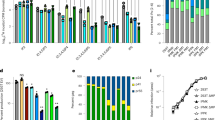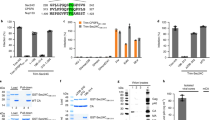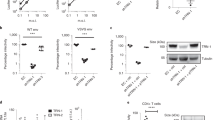Abstract
To form an immature HIV-1 capsid, 1,500 HIV-1 Gag (p55) polypeptides must assemble properly along the host cell plasma membrane. Insect cells and many higher eukaryotic cell types support efficient capsid assembly1, but yeast2 and murine cells3,4 do not, indicating that host machinery is required for immature HIV-1 capsid formation. Additionally, in a cell-free system that reconstitutes HIV-1 capsid formation, post-translational assembly events require ATP and a subcellular fraction5, suggesting a requirement for a cellular ATP-binding protein. Here we identify such a protein (HP68), described previously as an RNase L inhibitor6, and demonstrate that it associates post-translationally with HIV-1 Gag in a cell-free system and human T cells infected with HIV-1. Using a dominant negative mutant of HP68 in mammalian cells and depletion–reconstitution experiments in the cell-free system, we demonstrate that HP68 is essential for post-translational events in immature HIV-1 capsid assembly. Furthermore, in cells the HP68–Gag complex is associated with HIV-1 Vif, which is involved in virion morphogenesis and infectivity. These findings support a critical role for HP68 in post-translational events of HIV-1 assembly and reveal a previously unappreciated dimension of host–viral interaction.
This is a preview of subscription content, access via your institution
Access options
Subscribe to this journal
Receive 51 print issues and online access
$199.00 per year
only $3.90 per issue
Buy this article
- Purchase on Springer Link
- Instant access to full article PDF
Prices may be subject to local taxes which are calculated during checkout





Similar content being viewed by others
References
Boulanger, P. & Jones, I. Use of heterologous expression systems to study retroviral morphogenesis. Curr. Top. Microbiol. Immunol. 214, 237–260 (1996).
Jacobs, E., Gheysen, D., Thines, D., Francotte, M. & de Wilde, M. The HIV-1 Gag precursor Pr55gag synthesized in yeast is myristoylated and targeted to the plasma membrane. Gene 79, 71–81 (1989).
Mariani, R. et al. A block to human immunodeficiency virus type 1 assembly in murine cells. J. Virol. 74, 3859–3870 (2000).
Mariani, R. et al. Mouse-human heterokaryons support efficient human immunodeficiency virus type 1 assembly. J. Virol. 75, 3141–3151 (2001).
Lingappa, J. R., Hill, R. L., Wong, M. L. & Hegde, R. S. A multistep, ATP-dependent pathway for assembly of human immunodeficiency virus capsids in a cell-free system. J. Cell Biol. 136, 567–581 (1997).
Bisbal, C., Martinand, C., Silhol, M., Lebleu, B. & Salehzada, T. Cloning and characterization of a RNAse L inhibitor. A new component of the interferon-regulated 2-5A pathway. J. Biol. Chem. 270, 13308–13317 (1995).
Singh, A. R., Hill, R. L. & Lingappa, J. R. Effect of mutations in Gag on assembly of immature human immunodeficiency virus type 1 capsids in a cell-free system. Virology 279, 257–270 (2001).
Hynes, G. et al. Analysis of chaperonin-containing TCP-1 subunits in the human keratinocyte two-dimensional protein database: further characterisation of antibodies to individual subunits. Electrophoresis 17, 1720–1727 (1996).
Willison, K. et al. The T complex polypeptide 1 (TCP-1) is associated with the cytoplasmic aspect of Golgi membranes. Cell 57, 621–632 (1989).
Lingappa, J. R. et al. A eukaryotic cytosolic chaperonin is associated with a high molecular weight intermediate in the assembly of hepatitis B virus capsid, a multimeric particle. J. Cell Biol. 125, 99–111 (1994).
Traut, T. W. The functions and consensus motifs of nine types of peptide segments that form different types of nucleotide-binding sites. Eur. J. Biochem. 222, 9–19 (1994).
Salehzada, T., Silhol, M., Lebleu, B. & Bisbal, C. Polyclonal antibodies against RNase L. Subcellular localization of this enzyme in mouse cells. J. Biol. Chem. 266, 5808–5813 (1991).
Zhou, A., Hassel, B. A. & Silverman, R. H. Expression cloning of 2-5A-dependent RNAase: a uniquely regulated mediator of interferon action. Cell 72, 753–765 (1993).
Player, M. R. & Torrence, P. F. The 2-5A system: modulation of viral and cellular processes through acceleration of RNA degradation. Pharmacol. Ther. 78, 55–113 (1998).
Martinand, C. et al. RNase L inhibitor is induced during human immunodeficiency virus type 1 infection and down regulates the 2-5A/RNase L pathway in human T cells. J. Virol. 73, 290–296 (1999).
Kimpton, J. & Emerman, M. Detection of replication-competent and pseudotyped human immunodeficiency virus with a sensitive cell line on the basis of activation of an integrated β-galactosidase gene. J. Virol. 66, 2232–2239 (1992).
Smith, A. J., Srinivasakumar, N., Hammarskjold, M. L. & Rekosh, D. Requirements for incorporation of Pr160gag-pol from human immunodeficiency virus type 1 into virus-like particles. J. Virol. 67, 2266–2275 (1993).
Gheysen, D. et al. Assembly and release of HIV-1 precursor Pr55gag virus-like particles from recombinant baculovirus-infected insect cells. Cell 59, 103–112 (1989).
Hockley, D. J., Nermut, M. V., Grief, C., Jowett, J. B. & Jones, I. M. Comparative morphology of Gag protein structures produced by mutants of the gag gene of human immunodeficiency virus type 1. J. Gen. Virol. 75, 2985–2997 (1994).
Jowett, J. B., Hockley, D. J., Nermut, M. V. & Jones, I. M. Distinct signals in human immunodeficiency virus type 1 Pr55 necessary for RNA binding and particle formation. J. Gen. Virol. 73, 3079–3086 (1992).
Royer, M. et al. Functional domains of HIV-1 gag-polyprotein expressed in baculovirus-infected cells. Virology 184, 417–422 (1991).
Bukovsky, A. A., Dorfman, T., Weimann, A. & Gottlinger, H. G. Nef association with human immunodeficiency virus type 1 virions and cleavage by the viral protease. J. Virol. 71, 1013–1018 (1997).
Pandori, M. W. et al. Producer-cell modification of human immunodeficiency virus type 1: Nef is a virion protein. J. Virol. 70, 4283–4290 (1996).
Welker, R., Harris, M., Cardel, B. & Krausslich, H. G. Virion incorporation of human immunodeficiency virus type 1 Nef is mediated by a bipartite membrane-targeting signal: analysis of its role in enhancement of viral infectivity. J. Virol. 72, 8833–8840 (1998).
Cohen, E. A., Subbramanian, R. A. & Gottlinger, H. G. Role of auxiliary proteins in retroviral morphogenesis. Curr. Top. Microbiol. Immunol. 214, 219–235 (1996).
Madani, N. & Kabat, D. An endogenous inhibitor of human immunodeficiency virus in human lymphocytes is overcome by the viral Vif protein. J. Virol. 72, 10251–10255 (1998).
Simon, J. H. & Malim, M. H. The human immunodeficiency virus type 1 Vif protein modulates the postpenetration stability of viral nucleoprotein complexes. J. Virol. 70, 5297–5305 (1996).
Simon, J. H. et al. The regulation of primate immunodeficiency virus infectivity by Vif is cell species restricted: a role for Vif in determining virus host range and cross-species transmission. EMBO J. 17, 1259–1267 (1998).
Kozak, M. Interpreting cDNA sequences: some insights from studies on translation. Mamm. Genome 7, 563–574 (1996).
Folks, T. M. et al. Tumor necrosis factor α induces expression of human immunodeficiency virus in a chronically infected T-cell clone. Proc. Natl Acad. Sci. USA 86, 2365–2368 (1989).
Acknowledgements
Vif monoclonal antibody (TG001; Transgene) and Nef monoclonal antibody (EH1; gift of J. Hoxie) were provided by the AIDS Research and Reference Reagent Program, Division of AIDS, NIAID, National Institutes of Health. We thank J. Kucinski and F. Calayag for technical assistance; M. Hayden, T. Liegler, R. Grant and the Gladstone Institute, San Francisco, for assistance with HIV-infected cells; V. Kewalramani, D. Littman, M. Goldsmith and W. Hansen for advice or, reagents; L. Caldwell and the Electron Microscopy Laboratory at the Fred Hutchinson Cancer Research Center in Seattle; and V. Lingappa, J. Lingappa, J. Dooher, J. Overbaugh, J. M. McCune, M. Linial and R. Hegde for discussions. This work was supported by grants to J.R.L. from the National Institutes of Health AIDS Division, Pediatric AIDS Foundation, and the University of California Universitywide AIDS Research Program.
Author information
Authors and Affiliations
Ethics declarations
Competing interests
The authors declare no competing financial interests.
Supplementary information
Rights and permissions
About this article
Cite this article
Zimmerman, C., Klein, K., Kiser, P. et al. Identification of a host protein essential for assembly of immature HIV-1 capsids. Nature 415, 88–92 (2002). https://doi.org/10.1038/415088a
Received:
Accepted:
Issue Date:
DOI: https://doi.org/10.1038/415088a
This article is cited by
-
Depriving Iron Supply to the Virus Represents a Promising Adjuvant Therapeutic Against Viral Survival
Current Clinical Microbiology Reports (2020)
-
Robust Enhancement of Lentivirus Production by Promoter Activation
Scientific Reports (2018)
-
Host with the most: Targeting host cells instead of pathogens to fight infectious disease
Nature Medicine (2017)
-
Elucidating the in vivo interactome of HIV-1 RNA by hybridization capture and mass spectrometry
Scientific Reports (2017)
-
Evolution of the archaeal and mammalian information processing systems: towards an archaeal model for human disease
Cellular and Molecular Life Sciences (2017)
Comments
By submitting a comment you agree to abide by our Terms and Community Guidelines. If you find something abusive or that does not comply with our terms or guidelines please flag it as inappropriate.



